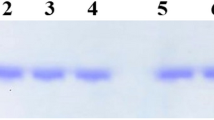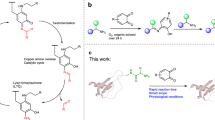Abstract
THE chemical modification of proteins with succinic anhydride was shown by Habeeb et al.1 to result in an unfolding of the compact conformations of several proteins in neutral aqueous buffer. This was attributed to the large increase in net negative charge produced by the replacement of the positively charged ε-NH3+ groups of lysine residues by negatively charged-NHCOCH2CH2COO-groups. An intensive study of the specificity of this reaction and of its conformational effects was made by Cherry2 with the protein bovine serum albumin; the results have been briefly reported3. Utilizing these findings, Klotz and Keresztes-Nagy4 made the interesting observation that the electrostatic repulsions introduced by succinylation could result in the complete dissociation of non-covalently linked sub-units of proteins, in particular, those of haemerythrin, at neutral pH without the addition of any other dissociating agents such as urea or detergent. We have now shown that rabbit γ-globulin, succinylated either before or after partial reduction of interchain disulphide bonds5, can be separated into its constituent heavy and light peptide chains5,6 by gel-filtration in aqueous buffers at pH near neutrality without the use of detergents7. Furthermore, the isolated succinylated heavy and light chains are quite soluble in such buffers, whereas isolated but unmodified heavy chains are insoluble6.
This is a preview of subscription content, access via your institution
Access options
Subscribe to this journal
Receive 51 print issues and online access
$199.00 per year
only $3.90 per issue
Buy this article
- Purchase on Springer Link
- Instant access to full article PDF
Prices may be subject to local taxes which are calculated during checkout
Similar content being viewed by others
References
Habeeb, A. F. S. A., Cassidy, H. G., and Singer, S. J., Biochim. Biophys. Acta, 29, 587 (1958).
Cherry, M., thesis, Univ. Yale (1964).
Cherry, M., Wofsy, L., and Singer, S. J., Abstr. Amer. Chem. Soc. Meeting, Washington, D.C., March 1962, 34C.
Klotz, I. M., and Keresztes-Nagy, S., Biochemistry, 2, 448 (1963).
Fleischman, J. B., Pain, R. H., and Porter, R. R., Arch. Biochem. Biophys., suppl. 1, 174 (1962).
Edelman, G. M., and Benacerraf, B., Proc. U.S. Nat. Acad. Sci., 48, 1035 (1962).
Utsumi, S., and Karush, F., Biochemistry, 3, 1329 (1964).
Fleischman, J. B., Porter, R. R., and Press, E. M., Biochem. J., 88, 220 (1963).
Habeeb, A. F. S. A., Fed. Proc., 24, 224 (1965).
Fuchs, S., and Sela, M., J. Biol. Chem., 240, 3558 (1965).
Author information
Authors and Affiliations
Rights and permissions
About this article
Cite this article
LENARD, J., SINGER, S. Succinylation of Gamma Globulin. Nature 210, 536–537 (1966). https://doi.org/10.1038/210536a0
Issue Date:
DOI: https://doi.org/10.1038/210536a0
This article is cited by
-
Characterization and Identification of Lysine Succinylation Sites based on Deep Learning Method
Scientific Reports (2019)
Comments
By submitting a comment you agree to abide by our Terms and Community Guidelines. If you find something abusive or that does not comply with our terms or guidelines please flag it as inappropriate.



